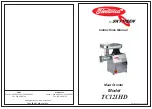
11
GENERAL INSPECTION
1/ Regularly check that all the fixing
Screws are tight, particularly the outer
flange. They may vibrate loose over time.
2/ The supply cord of the tool and any
extension cord used should be checked
frequently for damage if damaged have
the cord set replaced by an authorised
service facility. Replace the extension
cord if necessary.
LUBRICATION
The grease in the gearbox will require
replacement after extensive use of the tool,
please refer to an authorised service agent
to provide this service.
MAINTANCE
1/ Store the tool, instruction manual and
accessories in a secure place. In this way
you will always shave all the information
and parts ready to hand.
2/ Keep the tool’s air vents unclogged
and clean at all times.
3/ Remove dust and dirt regularly.
Cleaning is best done with compressed
air or a rag.
4/ Never use caustic agents to clean
plastic parts.
CAUTION
Do not use cleaning agents to clean the
plastic parts of the tool. A mild detergent on a
damp clotheIs recommended. Water must
never come in contact with the tool.
SYMBOLS
Some of the following symbols may be
used on your tool. Please study them and
learn their meaning. Proper interpretation
of these symbols will allow you to
operate the tool better and safer.
V
volts
A
amperes
Hz
hertz
W
watt
Kw
kilowatts
F
farads
microfarads
h
Hours
min
minutes
s
seconds
No load speed
/min or
minˉ¹
Revolutions or
reciprocations per minute
direct current
alternating current
two-phase alternating
current
2N
two-phase alternating
current with neutral
three-phase alternating
current
3N
three-phase alternating
current with neutral
Rated current of the
appropriate fuse-link in
amperes
Time-lag miniature fuse-link
where X is the symbol for
the time/current
characteristic, as given in
EN 60127
protective earthing at
earthing terminal, Class I
tools
Diameter
Off position
Arrow
Warning symbol
alternating or direct current
splash proof construction
watertight construction
class II construction
IPXX
IP symbol
²
































